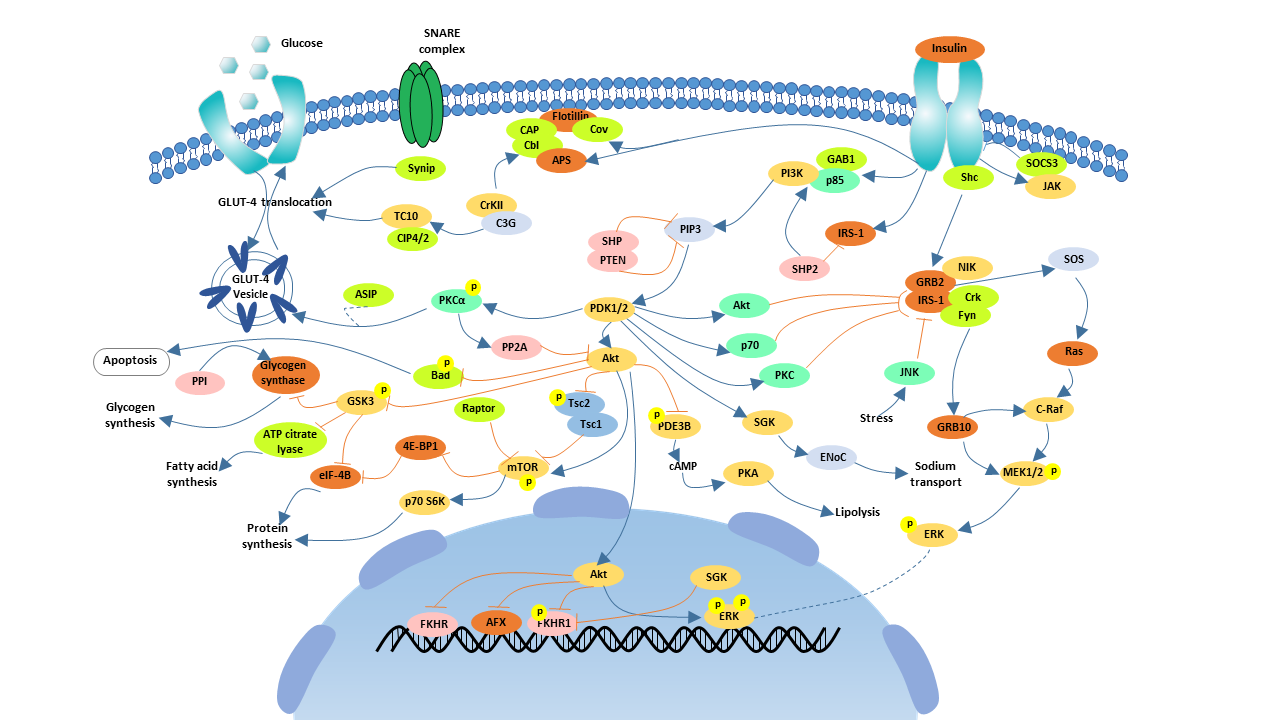
What is Insulin?
Sugar levels in the blood rise after eating, and the beta cells of pancreatic islets secrete insulin (Ins) to control the blood glucose in a normal range. Insulin is a protein hormone which is a key to unlock the cells, allowing the glucose to enter the cells and thereby lowering blood glucose levels.
The Role of Insulin
Insulin is the only hormone in the body that lowers blood sugar. When insulin binds to its receptors in target cells, it promotes the entry of extracellular glucose into these cells, where it is stored as glycogen. At the same time, insulin also inhibits the re-decomposition of glycogen into glucose, lowering blood sugar. Besides, insulin facilitates the synthesis of protein & fat and prevents the conversion of protein & fat to glucose. Inadequate insulin secretion can cause high blood sugar and may lead to diabetes.
What is Insulin Signaling Pathway?
The insulin signaling pathway is an approach that regulates glucose homeostasis by controlling important processes such as glucose and lipid metabolism.
The function of Insulin Signaling Pathway
The main function of the insulin signaling pathway is to assist insulin in regulating blood glucose homeostasis in the body, and works along with glucagon.
The Process of Insulin Signaling Pathway
The insulin receptor (InsR) is a tetramer, connected by two alpha and two beta subunits via disulfide bonds. Two alpha subunits, located on the outside of the cytoplasmic membrane, are responsible for binding insulin; while the two beta subunits are the transmembrane proteins that act as a signal transducer. Insulin binds to the alpha subunit of the insulin receptor on the target cells, changing the conformation of the beta subunit and thereby activating tyrosine kinase. This activity evokes auto-phosphorylation of the beta subunit, which subsequently leads to phosphorylation of intracellular proteins called insulin receptor substrates (IRS). Phosphorylation of IRS1 or IRS2 activates PI3K/Akt signaling pathway and Ras-Raf-MEK-MAPK signaling pathway.
The regulatory effect of insulin on metabolism is mainly mediated by the PI-3K (phosphoinositol 3 kinase) pathway. After activation of PI3K by IRS1, activated PI3K, catalyzes the phosphorylation of phosphatidylinositol (PI) across the membrane to produce PIP2 (phosphatidylinositol 4,5-bisphosphate) and PIP3 (phosphatidylinositol 3,4,5-triphosphate). PIP3 acts as a second messenger to recruit Akt and PDK1 (3-phosphoinositide dependent protein kinase-1) into the envelope region (PTEN pathway), where phosphorylation of PDK1 activates the serine/threonine residues of Akt. Akt regulates the translocation of the insulin-sensitive glucose transporter Glut4 within muscle and fat cells to the cell membrane for the extraction of glucose. Akt also phosphorylates glycogen synthase kinase (GSK), deactivating the enzyme, and inhibiting the activity of glycogen synthase (GS). Gsk-3 also inactivates eukaryotic promoter 2B, promoting the synthesis of protein-mediated by insulin. Insulin is phosphorylated by mTOR (molecular target of rapamycin) kinase and 4E-BPI, which promotes protein synthesis at the translation level. Meanwhile, this pathway also mediates the survival pathway of beta cells, which is closely related to the growth, proliferation, differentiation, and apoptosis of beta cells.
The MAPK pathway is activated when Grb2 (growth factor receptor-bound protein 2) binds to tyrosine-phosphorylated Shc (Sh2-containing collagen-related protein) or via Sh2 binding to insulin receptors. Grb2 is linked to mammalian nucleotide exchange factor mSOS. mSOS is a nucleotide exchange protein that promotes the conversion of GDP into GTP on Ras and activates Ras. P21Ras protein is anchored to the membrane by farnesienase, and Raf is recruited to the membrane and activated. Raf activates MAPK/Erk kinase (MEK). Extracellular signal-regulated kinase 1/2 (ERK1/2) regulates transcription factors associated with cell proliferation nucleus (ELK1, FOS) and EMT (Twist, ZEB1) to activate a variety of cancer gene and cell cycle regulatory proteins, promoting cell division, protein synthesis, and cell growth. And insulin also phosphorylates glycogen synthesis kinase-3β (GSK3β) and inactivates it, thereby activating oncogenes & transcription factors and promoting cell proliferation.
Factors Causing Insulin Signaling Pathway Dysfunction
Genetic variation and functional change of the protein molecules involved in the insulin signaling pathway cause abnormal signal transduction, which triggers insulin resistance. Other cytokines and metabolic factors such as TNF-α also indirectly contribute to insulin resistance. So these abnormalities are also targets of drug therapy for insulin resistance and related diseases.
The Diseases Associated with Insulin Signaling Pathway
The main cause of insulin resistance is impaired or reduced insulin signal transmission. Damage to any part of the insulin signaling pathway can lead to insulin resistance, which eventually causes metabolic syndrome and type II diabetes.
Studies have also found that insulin-mediated PI3K/Akt signaling pathway dysfunction is closely related to the onset and subsequent progression of Alzheimer's Disease (AD) in mice.
Other experiments have shown that improving the metabolism and signaling pathway of central insulin in mice can also help relieve the symptoms of mental diseases, such as schizophrenia and depression.



